Categories
Buildings: Purchased electricity
Track electricity consumption from various sources and calculate associated emissions.
This help article corresponds to the new version of the electricity calculator being rolled out in September 2024.
Updated: August 2024
Table of contents
Unbundled energy attribute certificates (EACs)
Overview
The purchased electricity feature helps you track electricity consumption from various sources and calculate the associated emissions. Sources include grid electricity procured from your local power company, electricity procured from suppliers on the open market and delivered via your local grid, electricity acquired from a microgrid, and renewable electricity generated on-site or purchased from an off-site source (including financial instruments).
Workiva Carbon provides an emissions output that reflects the physical delivery of electricity through the grid to your facilities (location-based method) and a separate output that considers deliberate electricity procurement decisions, including renewable energy instruments you purchase to compensate for fossil fuel-based electricity consumption (market-based method). When you report your emissions, it's best practice to disclose both the location-based and the market-based value.
Location-based emissions are calculated by applying an average grid emission factor representing all electricity production within a geographic boundary. Market-based emissions are calculated to represent individual corporate choices of electricity product. Market-based emissions calculations related to contractual instruments, such as renewable energy certificates or virtual power purchase agreements, rely on emission factors provided by the electricity provider. In the absence of supplier-derived emission factors, market-based emissions are calculated with residual mix emission factors. Occasionally, residual mix emission factors are unavailable for a region, so the location-based average emission factor is used once again.
How-to guide
Grid electricity
If electricity is delivered to you from your local utility—this applies to most organizations—regardless of who generated it, select “grid electricity”. If more than one utility serves your area, you may see a dropdown under Grid electricity. If so, select your electricity provider.
If you have a utility-specific (custom) emissions factor, toggle on "Custom grid factor". If you enter a custom factor from your utility, we assume that any renewables included in your mix are renewables that you can make claims on (i.e. the energy is bundled with energy attribute certificates). For example, if your utility providing you 100% renewable electricity and your custom factor is 0.0 g/kWh, we assume that your utility is transferring to you or retiring on behalf of you any renewable EACs associated with the electricity.
When entering grid electricity usage, enter the sum total of all the electricity you received from the grid inclusive of electricity from energy supply contracts and PPAs. Do not include electricity that you generated onsite or that was directly transferred to you.
Unbundled energy attribute certificates (EACs)
Use this section to track virtual power purchase agreements (VPPAs) and energy attribute certificates (e.g. RECs, GOs, I-RECs, TIGRs, J-Credits, NCFs and NZECs). Only report the amount you want to apply to your selected reporting month, as credits do not currently carry forward. Any EACs you claim for a given location should be relevant to the region of that location. For example, do not claim RECs for a European location, because RECs can only be used in North America. Additionally, do not claim any EACs for a given location or month if you have already entered them for another location or month, doing so will result in double counting.
The amount input under this section will reduce your market-based emissions. It will not reduce your location-based emissions.
Energy supply contracts
If you purchased electricity from a specific energy supplier or generator you can track them as an energy supply contract. Check the box and select “add contract”. In the side pane, type in the provider’s name.
If the electricity you purchase is completely or partially renewable, type in the percentage of renewable electricity under “bundled renewable energy”. We assume that any energy attribute certificates for renewable electricity are transferred to you or retired on your behalf. If they are not, enter 0%.
If you have a custom emission factor from the provider, add this as well. We assume that any renewables included in your mix are renewables that you can make claims on (i.e. the energy is bundled with energy attribute certificates). You can include notes and attachments to record details about your contract. If your contract is partially renewable, include the percentage under “Bundled renewable energy”. Click save.
Onsite generation
Renewable
In this section, you can track renewable onsite generation that you export back to the grid, as well as electricity you consume onsite. If you have a net-metered system where you deliver all the electricity to the grid and your utility then provides you a credit on your utility bill, select Exported to grid. To track a credit or reduction in your bill from a net metering arrangement, reduce the spend you enter into the "Total grid" column.
If you export your renewable electricity to the grid, indicate whether you retain the associated EACs or not. In most cases, if your utility provides monetary reward in exchange for renewable electricity you generated, you no longer have the right to claim the "renewableness" of that energy. If you do retain the EACs, you can toggle on “EACs retained” to ensure this electricity is factored against your total grid usage. EACs that you retain are treated like unbundled EACs.
For energy consumed onsite, it is assumed that you did not generate and sell EACs for the energy, so there is no emissions associated with this energy consumption. If you did generate and sell EACs, toggle off “EACs retained”. In this case, Workiva Carbon will apply the same emissions factor as your local grid for your market-based emissions, because you cannot claim this electricity as renewable.
Non renewable
If you generate electricity onsite from fossil fuels, enter the amount of electricity you generated here. Any fossil fuels you burn to generate electricity should be entered under Stationary Combustion so that the emissions are calculated in your Scope 1 inventory. We track the electricity produced here simply to provide you a full picture of your electricity use.
Directline Transfer
Use this section to track electricity you get from a direct line, not through the grid. For example, electricity transmitted to you via a local microgrid. If your supplier generates electricity with renewables AND conveys the associate EACs/RECs to you, indicate the % of electricity that is covered by EACs/RECs.
If your suppler provides you with a custom factor, enter it here. Otherwise, Workiva Carbon will use the local grid factor to calculate emissions as a proxy.
Make sure to save your selections before continuing on to adding data.
Add electricity data
Click the plus icon to add a single entry. For bulk upload, select the up arrow. To set up a utility integration, click the lightning bolt.
Utility integration
Select your location and provider and follow the instructions until your setup is complete. See our integrations help guide for more details.
Bulk import
Edit the start and end dates for your data set as needed and ensure that the units of measure for each field match your inputs. If you have other sources of emissions configured for your buildings (such as natural gas) you’ll see them on this screen, these can be ignored. Once you’ve configured the template, proceed to download template.
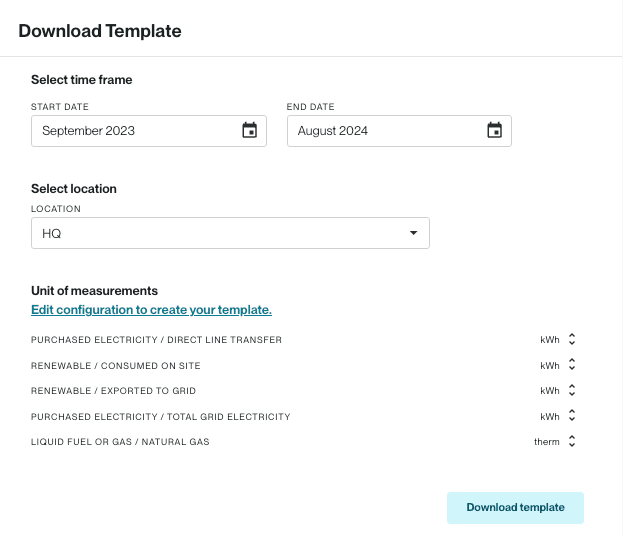
Populate the orange fields in the file with your consumption or spend for each line item for each month. For the above configuration, we selected grid electricity, onsite renewables consumed onsite, onsite renewables exported to grid, and directline transfer, so each shows up as a line item. You’ll only see items you selected during configuration. As with the previous screen, if you have other sources of emissions from your buildings, they’ll show up in this template. Uploading blank fields will not override any data you’ve previously uploaded.
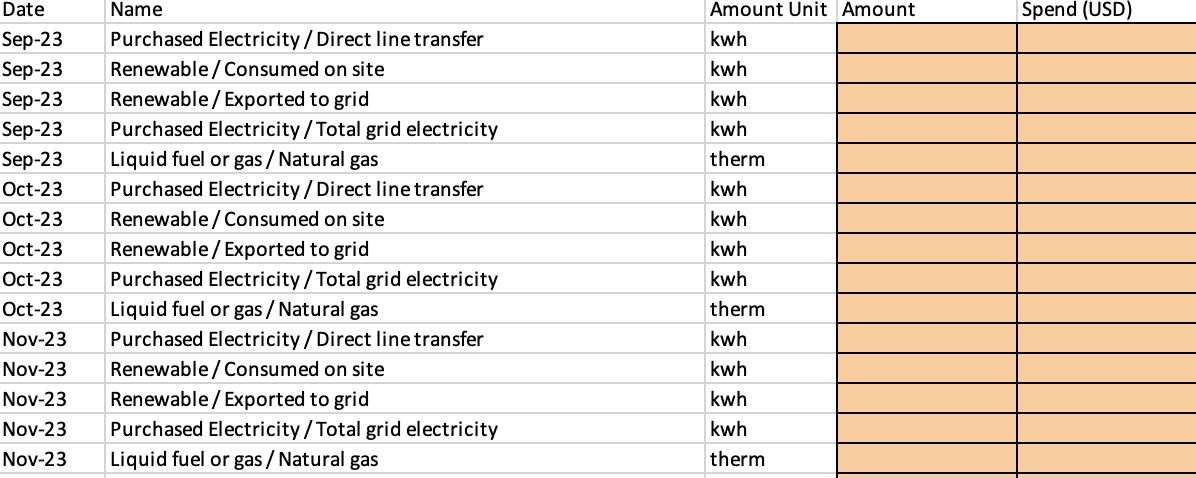
When complete, upload your file.
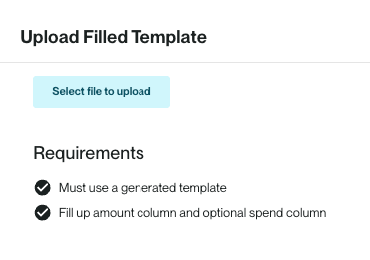
Manual entry
Make sure you select the correct location and month and enter your data into the form.
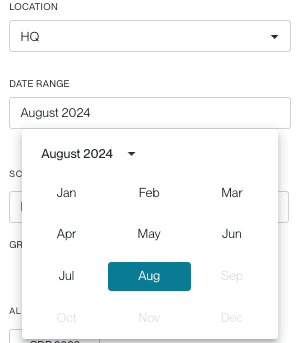
Be sure to select the correct unit of measure for each entry. Your emissions will be computed in real-time as you enter consumption data. Save when you’re done or reset the form to start over.
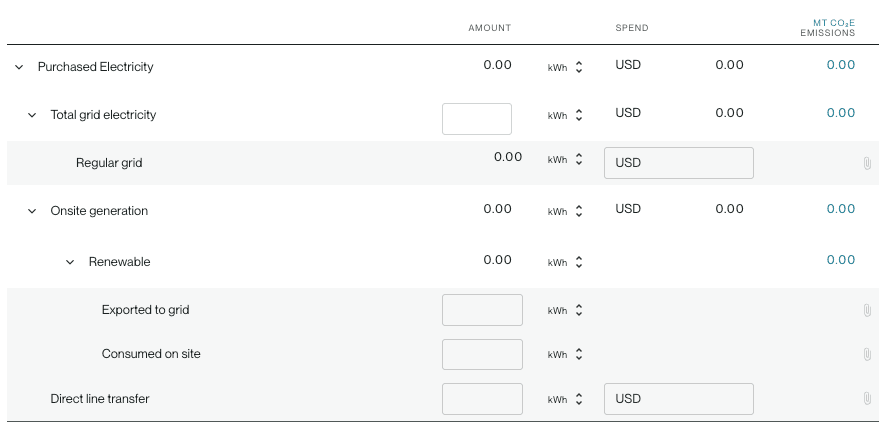
Definitions
-
Amount – Refers to the electricity consumption amount associated with the reporting interval.
-
Custom factor – An emissions factor specific to the energy mix. Custom factors are often unavailable, but some suppliers may specify them in energy supply contracts or provide them upon request.
-
Direct line microgrid (fossil fuel) – Microgrids are energy systems that are separate from and much smaller than traditional regional grids. They can supply a building, a campus or a community. Direct line microgrids are connected and supply electricity to specific locations, i.e., they do not feed into a larger grid.
-
Energy supply contract – In this context, a legal agreement negotiated by an energy supplier or broker and an energy buyer for the purchase of electricity (fossil fuel-based, from renewable sources, or a mix) or environmental attributes (e.g., RECs/I-RECs, GO’s). Contractual instruments cover a specified contractual period, usually at least one year, and a price per unit. Supply contracts can also be executed for equity investments, virtual power purchase agreements, and other financial arrangements for the purchase of renewable energy.
-
Grid electricity – Electricity delivered through a grid in the region you operate. Commonly, companies buy electricity at standard commercial electricity rates from their local power company and are usually invoiced monthly based on meter readings. But electricity purchased through energy supply contracts is also often delivered through the same grid network.
-
Total grid electricity – The sum of all electricity purchases, with or without energy supply contracts, which are delivered to your location through the regional grid.
-
Regular (default) grid electricity – Electricity purchased at standard commercial rates through your power company without energy supply contracts and delivered to your location through the regional grid.
-
-
Onsite generation, non renewable – Uncommon, but occurs when a company generates electricity by burning fossil fuels onsite. For example, a company may operate a generator to produce electricity. Workiva Carbon does not calculate emissions here, as they fall under scope 1 emissions from stationary combustion, however, Workiva Carbon includes the electricity consumption in your total kWh/MWh output. If you have onsite fossil fuel generation, be sure to enter your fossil fuel consumption in the stationary combustion section of Buildings.
-
Onsite generation, renewable – Onsite renewable systems that generate electricity such as rooftop solar, wind, or hydropower systems. See our section on \onsite renewables to learn how to enter electricity from these systems.
-
Spend – Expenditures from electricity purchases. Enter either cost of electricity including fees and taxes or only the cost associated with units of electricity purchased. The former will help you track your entire electricity budget, while the latter will provide outputs based only on cost per kWh. This should be an internal decision based on the type of analysis you plan to perform. Whichever you choose, it’s important to stay consistent in all your reporting. Be sure to include both supply and delivery costs. If you have a third-party energy supplier, your supply costs may come from a separate bill. If you purchase environmental attribute certificates (such as RECs), the cost of those certificates should also be tracked.
Unbundled EACs – Any form of renewable energy your company has acquired and that is not generated on site. This can be in the form of financial instruments (e.g., RECs, GOs, VPPAs), equity investments, or renewable energy aggregation projects.
FAQs
Consumption data
Where do I obtain electricity consumption data?
Most companies find the consumption in kWh on their electricity bills. Some take periodic meter readings or pull the data from an energy management system. For companies in leased spaces where the property owner contracts the electricity, Workiva Carbon provides a downloadable workbook (in the downloads section) for tenants and property owners to compute prorated emissions.
Can I upload historical data or transfer my online consumption history from the power company to Workiva Carbon?
Yes. It’s recommended to use bulk uploads for historical data. Workiva Carbon also offers an automated transfer of your consumption and spend data from your power company, provided your power company is a listed utility provider in Workiva Carbon’s database or can be added.
Which electricity consumption value do I enter from my bill?
Look for consumption in kWh for the billing period. This is sometimes broken out into peak and off-peak usage because your power company may charge a higher rate for peak energy consumption. In that case, add the two values. Consumption could also be broken out by meter. If those meters serve the same location, add consumption from each meter.
Can I report multiple meters associated with the same building or multiple buildings associated with the same meter?
You can report multiple meters associated with the same building by adding consumption amounts for these meters. If a single meter serves more than one building, you can either prorate consumption for each building, or treat the group of buildings as one location, especially if the buildings share an address. However, if grouping buildings, be aware that this can impact the tracking of other metrics and distort the analysis in reports Workiva Carbon provides. It’s recommended to prorate electricity for buildings with separate addresses and combine it for buildings with the same address, unless you want to analyze these buildings separately (e.g., an office and associated retail building).
My property owner manages the electricity for our space. What information do I need to request from them?
If you’re the sole tenant, ask them to share consumption in kWh from the electricity bills. If you’re in a multi-tenant building, download our tenant proration Excel tool. Use this workbook with your property owner to obtain prorated consumption values.
What if I'm unable to obtain electricity & natural gas use data for my buildings?
Obtaining actual usage data for your electricity is key to building an accurate inventory. If you're unable to obtain accurate data, estimating this data is acceptable but should be noted in any reporting of your emissions it is recommended that you prioritize creating systems to obtain your electricity consumption. If you are located in the U.S., you can download our Building Electricity & Natural Gas Estimation Tool which uses benchmarking data from the U.S. Department of Energy's Commercial Building Energy Consumption Survey (CBECS).
How would we enter data if we're in a shared co-working space (e.g. WeWork)?
If you're simply paying for a monthly or annual membership (i.e. It's similar to a gym membership benefit you can provide employees), then it'd be considered Scope 3, Purchase Goods & Services. If you have a lease you'd treat this similar to any other lease. If the co-working space does not provide you a utility bill or a square footage of your space, you can estimate your square footage based on headcount. Typically, an office will have an occupancy density of 1 person per 200 square feet. This guidance comes from an engineering standard called ASHRAE 62.1. This standard is what most countries reference for building codes. In reality, you can see this value being much larger or smaller. If possible, we'd recommend measuring the office space to get a more accurate number. Then, you can use the estimation tool mentioned above.
Renewable energy
Where do I enter green power/REC purchases I’ve made through my local power company?
Enter them as unbundled EACs.
How should I enter electricity from an on-site renewable system such as a rooftop solar arrangement?
Following the Greenhouse Gas Protocol, your electricity emissions are determined by your gross electricity use. Therefore, you should enter your gross electricity use into Total grid electricity and the amount of electricity from the onsite system that you consume into Onsite generation > Renewable > Consumed onsite. Electricity that you export to the grid does not provide you with any credit or reductions on your inventory, therefore, you do not need to enter electricity that you exported to the grid.
For example, your onsite solar system produce 1,000 kWh of electricity, 600 kWh you consumed onsite while 400 kWh you exported to the grid. Meanwhile, you pulled 3,000 kWh from the grid. Enter 3,000 kWh in Total grid electricity, 600 kWh into Consumed onsite, and 400kwh into Exported to grid. Your utility might report your net electricity consumption to you (which is 2,600 kWh) but this can be ignored. This example assumes that you retain the energy attribute credits (e.g. RECs) from the 600 kWh of electricity you consume onsite, contact us if your circumstances vary.
Where do I enter electricity from a community solar project?
First, you should verify that your community solar project conveys the energy attribute certificates to you (e.g. RECs). Many community solar programs do not actually convey the certificates to you, even though they claim to be renewable. You should review the fine print of your contract agreement to determine this. If they do not convey the certificates to you, then you cannot claim to be using renewable electricity.
If you community solar project does give you certificates to you, then enter it based on it's location relative to you. If it is offsite to you, enter it as Unbundled EACs. If it is onsite to you and is not connected to the grid, enter it as Onsite generation > Renewable > Consumed onsite.
Where do I enter renewable electricity we receive through a direct line to a renewable energy project?
Enter this as offsite renewables.
How can I get credit for renewable sources in our default grid mix?
Renewable sources incorporated into your grid mix are accounted for in the emission factors Workiva Carbon applies to your consumption amounts. However, some companies do want to take credit for renewable sources in the grid mix more accurately, especially when they are significant (e.g., to support a renewable energy goal). In that case, you can account for the renewable sources in the offsite renewable field. To account for the remaining fossil fuel mix, you will need to obtain an emission factor from the power provider. You can enter that portion as an energy supply contract and specify the emission factor (while it isn’t technically an energy supply contract, this is how Workiva Carbon can currently account for custom factors in edge cases).
Energy supply contracts
Are energy supply contracts only for renewable energy?
No. A company can enter into fossil fuel contracts as well and may do so to stabilize pricing if they expect an increase in energy prices. An energy supply contract can be for fossil fuels only, for renewables only, or for a mix of the two, sometimes specifying the minimum % of renewable energy in the mix.
What if my energy supply contract doesn’t show an emissions factor specific to the electricity mix I purchase?
Most contracts don’t show these factors yet. You can ask your broker or supplier if they are available. Workiva Carbon uses the grid default factor if a custom factor is unavailable.
Can I purchase Renewable Energy Credits (REC's) in any market?
While the Greenhouse Gas Protocols have not offered guidance here, RE100 has. The RE100 initiative sets out the detailed criteria for procuring renewable energy (RE) for your operations. To follow best practices for procuring RE, a company typically uses RE100's criteria, which also aligns with the requirements set by SBTi for target-setting (SBTi refers to RE100 for RE procurement). RE100 considers the USA and Canada as one market. So if you buy a REC in the USA, it can be used for your Canadian operations and vice versa. This is similar in many EU countries. For more detailed, we'd recommend referencing the RE100 guidance directly.
Troubleshooting
Why am I getting an “invalid total grid electricity” error?
Energy supply contracts are nested below total grid electricity, so the amount you enter must at least equal the sum of your energy supply contracts consumption. The electricity you purchase from these suppliers is delivered through the grid and therefore factors into the total. The total can be higher if you buy electricity from the grid at standard commercial rates without an energy supply contract in place.
I don’t have monthly data. How can I use the form?
For this calculator, monthly data is ideal to track seasonal fluctuations in energy use. However, if you can only obtain, for example, an annual total, you can prorate this total across the twelve months of the year and enter it into Workiva Carbon that way. You won’t see month-to-month changes in your emissions, but your annual emissions will be accurate. Alternatively, enter the annual total in December, but be aware that the report visualizations are optimized for monthly reporting.
How can I view location-based emissions?
For all entries, both market-based and location-based emissions are calculated. Within the entry, you can toggle market-based and location-based to view each calculation output. You can see the detailed audit for both the market-based and location-based emissions within the Audit feature.
I don't have any contractual instruments. Why are my market-based emissions higher than my location-based emissions?
Market-based emissions consider residual mix emission factors. A residual mix emission factor represents the emissions and generation that remain after certificates, contracts, and supplier-specific factors have been reconciled against the regional electricity mix. These factors are often higher than regional factors due to the green commodities sold out of local grids. Because of this, if your company does not have renewable contracts, your scope 2 market-based accounting emissions may be higher than your location-based emissions.
Methodology
Copyright 2026 Sustain.Life All rights reserved